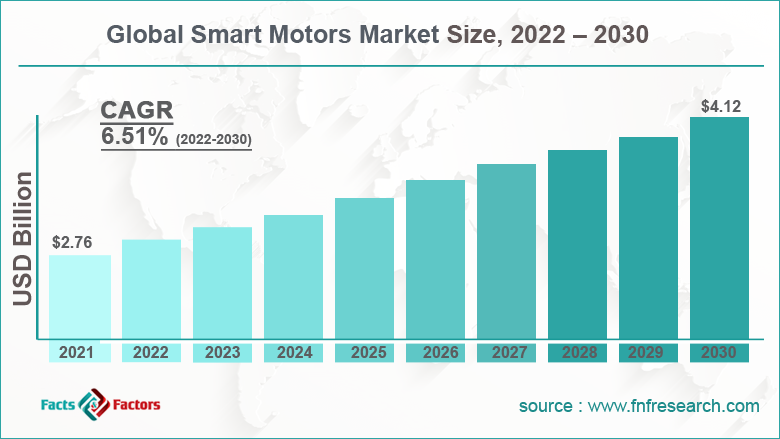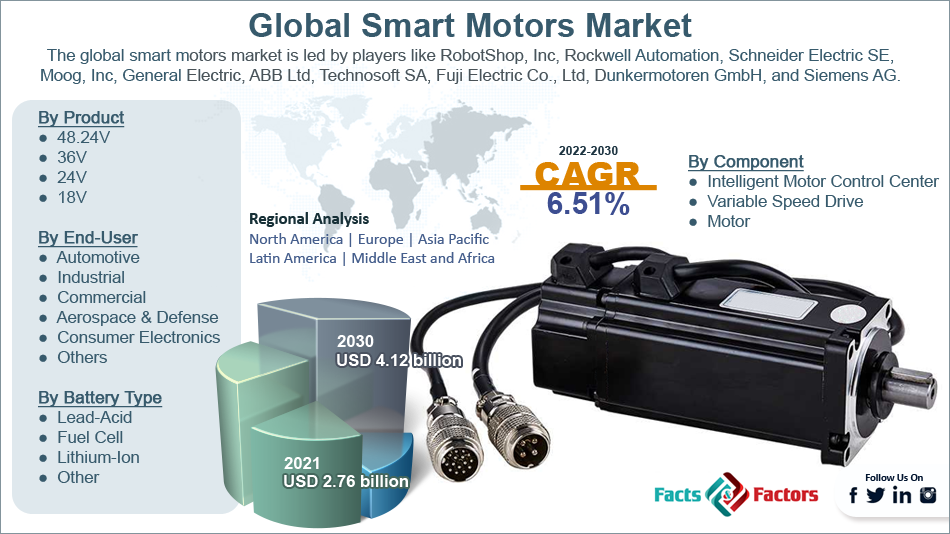Search Market Research Report
Smart Motors Market Size, Share Global Analysis Report, 2022 – 2030

Smart Motors Market Size, Share, Growth Analysis Report By Component (Intelligent Motor Control Center, Variable Speed Drive, and Motor), By Product (48.24V, 36V, 24V, and 18V), By End-User (Automotive, Industrial, Commercial, Aerospace & Defense, Consumer Electronics, and Others), By Battery Type (Lead-Acid, Fuel Cell, Lithium-Ion, and Other), and By Region - Global and Regional Industry Insights, Overview, Comprehensive Analysis, Trends, Statistical Research, Market Intelligence, Historical Data and Forecast 2022 – 2030
Industry Insights
[222+ Pages Report] According to the report published by Facts and Factors, the global smart motors market size was worth around USD 2.76 billion in 2021 and is predicted to grow to around USD 4.12 billion by 2030 with a compound annual growth rate (CAGR) of roughly 6.51% between 2022 and 2030. The report analyzes the global smart motors market drivers, restraints/challenges, and the effect they have on the demands during the projection period. In addition, the report explores emerging opportunities in the smart motors industry.

 Market Overview
Market Overview
Smart motors refer to a motor that can efficiently integrate multiple components under one roof or into one physical unit Typically smart motors consist of a drive and a motor but in some cases, they may be built along with controllers and encoders along with communication ports and cabling systems. Smart motors have become extremely popular in the modernized world because of the superior performance delivered by them in comparison to traditional motors. One such exceptional feature is the enhanced connectivity attribute which allows businesses to produce and manufacture complex motion control systems or industrial machinery with utmost ease.
 Key Insights
Key Insights
- As per the analysis shared by our research analyst, the global smart motors market is estimated to grow annually at a CAGR of around 6.51% over the forecast period (2022-2030)
- In terms of revenue, the global smart motors market size was valued at around USD 2.76 billion in 2021 and is projected to reach USD 4.12 billion, by 2030.
- The smart motors industry is projected to grow at a significant rate due to the growing need for energy consumption
- Based on end-user segmentation, automotive was predicted to show maximum market share in the year 2021
- Based on component segmentation, variable speed drive was the leading component in 2021
- On the basis of region, Asia-Pacific was the leading revenue generator in 2021

 Growth Drivers
Growth Drivers
- Growing need for energy consumption to propel market demand
The global smart motors market is projected to grow owing to the rising need for energy consumption amongst business sectors as a means of optimizing the final revenue or profit. A sustainable business cannot be built just by improving sales. There are several other factors that have to be prioritized if a business intends to run for a long time. For any business operation activity, energy is one of the most important raw materials or initial inputs, and with the rising industrialization, the corresponding energy consumption has broken all previous records.
However, there is currently a great emphasis on reducing or optimizing energy consumption which directly translates to the overall efficiency of a business. Smart motors can prove to be cost-efficient and help the end-user reduce the demand for energy given the smart technology installed in smart motors. For instance, the switched reluctance technology in the advanced motors helps them use electricity only when it is required, unlike traditional motors that are known to drain large amounts of power when not in use.
 Restraints
Restraints
- High capital cost to restrict market expansion
Smart motors deploy advanced technology which means that in most cases it will necessitate the need for additional components to perform as per expectations. Traditional motors use simple mechanical systems, however, smart motors are a mixture of mechanical as well as technical sub-parts. These aspects lead to an increase in the final cost of using the system and hence require high initial capital cost which means that small or mid-size firms may not be able to leverage the benefits of smart motors due to the high expense. This could potentially limit the smart motors industry growth during the forecast period.
 Opportunities
Opportunities
- Increasing need for customization to provide growth opportunities
Every organization has separate requirements and no two businesses are alike in the modern dynamic world. Every company operating in the commercial market has a different product or related service to offer. This means that the need for customizing operational devices, pieces of machinery, or other input products is higher than ever which is expected to create more demand for smart motors with varying and adjustable speeds or frequencies during the forecast period. Furthermore, constant research and product innovation in the field could create higher growth opportunities for the global smart motors market.
 Challenges
Challenges
- Lack of knowledge a major challenge for market players
One of the major challenges that the global market players face is in terms of lack of knowledge amongst the end-user verticals in terms of the product benefits and the importance of methods of energy saving. In countries where there is an absence of strict policies monitoring adherence to energy-saving methods at the commercial or industrial level, businesses tend to ignore the cost of operations on the environment due to overconsumption of energy or power. The ignorance or complete lack of knowledge on energy-saving ways could cause a loss of revenue during the smart motors industry growth period.
 Segmentation Analysis
Segmentation Analysis
The global smart motors market is segmented based on component, product, end-user, battery type, and region
Based on component, the smart motors industry is divided into intelligent motor control center, variable speed drive, and motor
- In 2021, the global market registered the highest growth in the variable speed drive (VSD) segment. It is responsible for controlling or managing the energy that is used by the main system to carry out a certain process
- This component is placed between the motor and the energy supply. The various steps involved during the time energy is fed from the main supply to the final component help in saving a large amount of energy
- Apart from energy efficiency, the VRD components also allow to maintain cost along with reducing noise emissions and waste
- As per official reports, the use of smart motors can help save 50% of energy on average.
Based on product, the market is divided into 48.24V, 36V, 24V, and 18V.
Based on battery type, the market divisions are lead-acid, fuel-cell, lithium-ion, and others
Based on end-user, the smart motors industry is segmented into automotive, industrial, commercial, aerospace & defense, consumer electronics, and others.
- The global market registered the highest growth in the automotive segment in 2021 and it is expected to grow at a CAGR of 15.21% during the forecast period.
- The growing applications in the industry given the rising demand for automotive influenced by factors like availability of products across the price range, rising financial assistance, growing disposable income, and constant product innovation could lead to higher demand for smart motors directed toward easing the process of manufacturing
- The device can improve the production cycle and assist in improving overall efficiency
 Recent Developments:
Recent Developments:
- In March 2020, Siemens, a Germany-based multinational conglomerate, announced a partnership with NEC Corporation, a Japanese multinational information technology company. The collaboration will be directed toward the production of a manufacturing solution that will be built using NEC’s System Invariant Analysis Technology (SIAT) along with cloud-based open Internet of Things (IoT) operating system by Siemen, called MindSphere
- In March 2020, Cylon Controls Limited was acquired by ABB Ltd, a Swedish-Swiss multinational corporation. The move allowed ABB to strengthen the company’s Electrification segment and better hold over the commercial building sector. Cyclon is run by around 100 employees and is a provider of heating, ventilation, and air conditioning (HVAC) and building automation systems
 Report Scope
Report Scope
Report Attribute |
Details |
Market Size in 2021 |
USD 2.76 Billion |
Projected Market Size in 2030 |
USD 4.12 Billion |
CAGR Growth Rate |
6.51% CAGR |
Base Year |
2021 |
Forecast Years |
2022-2030 |
Key Market Players |
Robot Shop, Inc, Rockwell Automation, Schneider Electric SE, Moog Inc, General Electric, ABB Ltd, Technosoft SA, Fuji Electric Co. Ltd, Dunkermotoren GmbH, Siemens AG., and others. |
Key Segment |
By Component, Product, End-User, Battery Type, and Region |
Major Regions Covered |
North America, Europe, Asia Pacific, Latin America, and the Middle East &, Africa |
Purchase Options |
Request customized purchase options to meet your research needs. Explore purchase options |
 Regional Analysis
Regional Analysis
- Asia-Pacific to register the highest growth during the forecast period
The global smart motors market is projected to witness a growth of 8.31% CAGR in Asia-Pacific during the forecast period which is expected to become its most dominant region. The changing energy concerns in the countries of India, China, Japan, South Korea, and other economies could be the growth driving factor. The regions are witnessing a surge in foreign players' entries along with an exceptionally well-growing domestic market across sectors with more demand for mass production to meet the increasing demand from consumers.
Furthermore, Asia-Pacific is the hotspot for the manufacturing segment which is propelling the need for the adoption of advanced systems that can help maintain a balance between demand and supply. One of China’s major economy-propelling sectors is the manufacturing unit. North America could be led by the constant research & development for the production of better systems driven by the growing need in the end-user verticals.
 Competitive Analysis
Competitive Analysis
- RobotShop Inc
- Rockwell Automation
- Schneider Electric SE
- Moog Inc
- General Electric
- ABB Ltd
- Technosoft SA
- Fuji Electric Co. Ltd
- Dunkermotoren GmbH
- Siemens AG.
The global smart motors market is segmented as follows:
 By Component Segment Analysis
By Component Segment Analysis
- Intelligent Motor Control Center
- Variable Speed Drive
- Motor
 By Product Segment Analysis
By Product Segment Analysis
- 48.24V
- 36V
- 24V
- 18V
 By End-User Segment Analysis
By End-User Segment Analysis
- Automotive
- Industrial
- Commercial
- Aerospace & Defense
- Consumer Electronics
- Others
 By Battery Type Segment Analysis
By Battery Type Segment Analysis
- Lead-Acid
- Fuel Cell
- Lithium-Ion
- Other
 By Regional Segment Analysis
By Regional Segment Analysis
- North America
- The U.S.
- Canada
- Mexico
- Europe
- France
- The UK
- Spain
- Germany
- Italy
- Nordic Countries
- Denmark
- Sweden
- Norway
- Benelux Union
- Belgium
- The Netherlands
- Luxembourg
- Rest of Europe
- Asia Pacific
- China
- Japan
- India
- Australia
- South Korea
- Southeast Asia
- Indonesia
- Thailand
- Malaysia
- Singapore
- Rest of Southeast Asia
- Rest of Asia Pacific
- The Middle East & Africa
- Saudi Arabia
- UAE
- Egypt
- South Africa
- Rest of the Middle East & Africa
- Latin America
- Brazil
- Argentina
- Rest of Latin America
Industry Major Market Players
- RobotShop Inc
- Rockwell Automation
- Schneider Electric SE
- Moog Inc
- General Electric
- ABB Ltd
- Technosoft SA
- Fuji Electric Co. Ltd
- Dunkermotoren GmbH
- Siemens AG.
Frequently Asked Questions

Copyright © 2024 - 2025, All Rights Reserved, Facts and Factors


